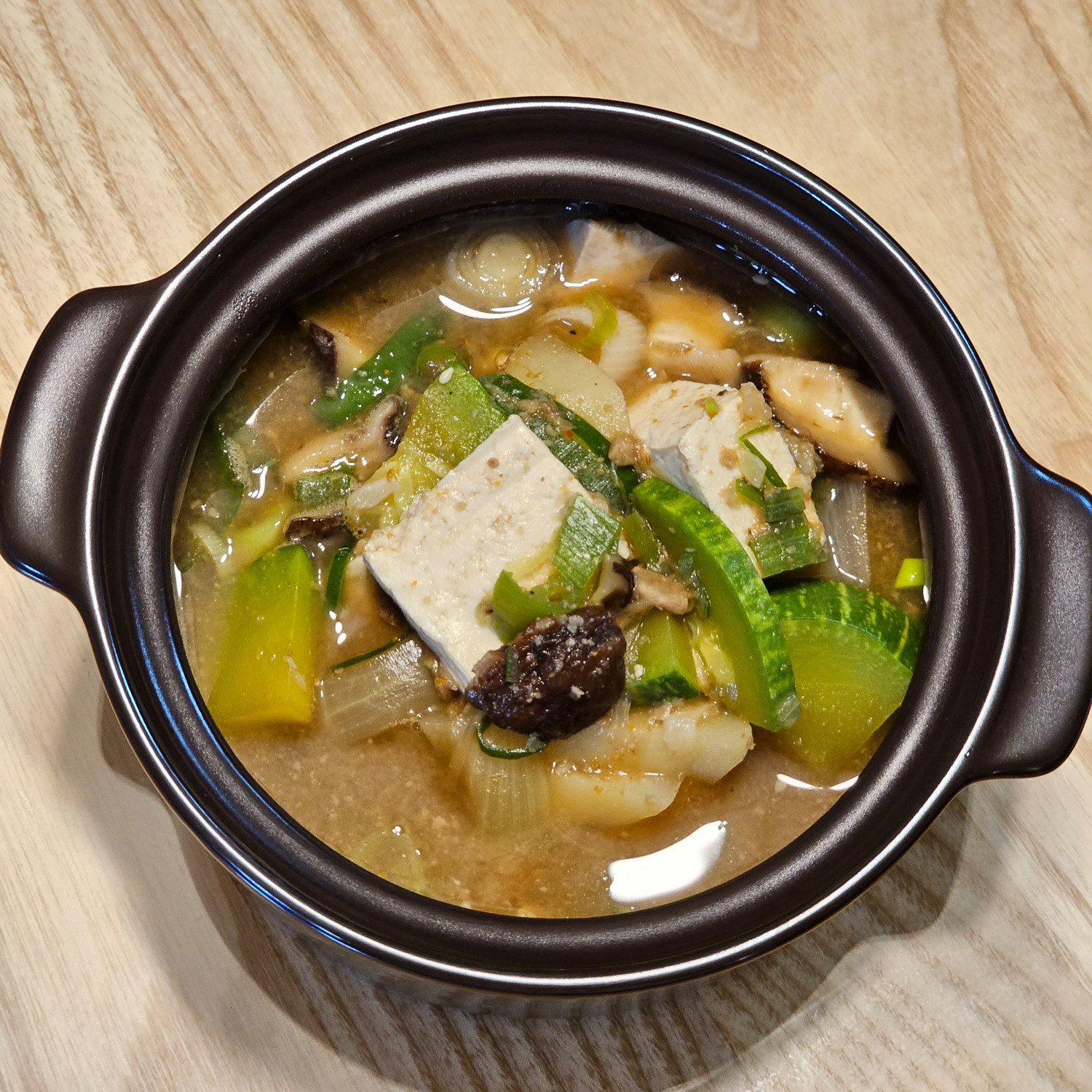Hearty Korean Soybean Paste Stew (Doenjang Jjigae) with Anchovy-Kelp Broth
The Quintessential Home-Cooked Meal: A Delicious Doenjang Jjigae Recipe Made with Rich Anchovy and Kelp Broth

Introducing a recipe for Doenjang Jjigae, a beloved Korean stew, simmered with a flavorful broth made from anchovies and kelp, packed with fresh vegetables and tofu. This dish is simple to prepare and makes for a satisfying meal, perfect for any day. It’s so delicious, it might just become your new favorite comfort food!
Stew Ingredients- Water 500ml (approx. 2 cups)
- Dried Kelp (Dashima) 2 pieces (about 5x5cm each)
- Dried Anchovies (for broth) 10 pieces
- Zucchini 1/3 medium
- Mushrooms (Shiitake or King Oyster) 3 medium
- Green Onion 1/4 stalk
- Onion 1/2 medium
- Potato 1 medium
- Firm Tofu 1/2 block (approx. 150g)
- Minced Garlic 1/2 Tbsp (about 3 cloves)
- Green or Red Chili Pepper 1 (optional)
- Doenjang (Korean Soybean Paste) 1.5 Tbsp (approx. 30g)
Cooking Instructions
Step 1
First, let’s prepare the broth that gives this stew its deep flavor. In a pot, combine 500ml of cold water with 2 pieces of dried kelp and about 10 dried anchovies. Bring to a boil over medium-high heat, then immediately reduce to low heat and simmer gently for 10 minutes to extract the rich broth. (Note: Kelp can become bitter if boiled for too long, so it’s best to remove it after 10 minutes, along with the anchovies.) While the broth is simmering, you can efficiently prepare the vegetables and other ingredients.

Step 2
Wash the zucchini, mushrooms, green onion, onion, potato, and tofu thoroughly. Peel the garlic cloves. If using chili peppers, remove the seeds and slice them thinly to add a touch of heat. (Optional: If you prefer less spice, you can omit the chili peppers or adjust the quantity.)

Step 3
Peel the potato, or wash it well if you prefer to leave the skin on. Cut it in half, then slice into approximately 0.5cm thick, flat pieces. This size ensures the potato cooks through to a tender consistency without falling apart too easily.

Step 4
Cut the onion in half, then slice it into thick strips about 0.5cm wide. Slicing them slightly thicker prevents them from becoming mushy as they cook, preserving a pleasant texture.

Step 5
Cut the zucchini in half, then slice into half-moon shapes about 0.5cm thick, or as shown in the photo. Avoid slicing them too thinly so they retain a nice bite, even for picky eaters.

Step 6
Trim the tough stems from the mushrooms and cut the caps into bite-sized pieces, about three per mushroom. If using shiitake mushrooms, brush off any dirt from the stems. King oyster mushrooms are great for their firm texture in Doenjang Jjigae.

Step 7
Slice the green onion diagonally into pieces about 2-3cm long, including both the white and green parts. This will add a fragrant aroma to the stew when added at the end.

Step 8
Cut the tofu into large, bite-sized cubes (about 2cm). Mince the 3 garlic cloves finely to enhance the stew’s umami. Slice the chili pepper thinly for a hint of spice. (Optional: Use a Korean green chili pepper for extra heat.)

Step 9
All the ingredients are now prepped! Seeing them ready makes me look forward to the delicious meal.

Step 10
Remove the kelp and anchovies from the broth in the pot, leaving only the clear broth. Now it’s time to dissolve the Doenjang (soybean paste) into this broth to create the base for our stew. Dissolving the paste beforehand prevents clumps and ensures a smooth consistency.

Step 11
Use about 1.5 tablespoons of Doenjang. Adjust the amount based on the saltiness and fermentation level of your specific Doenjang. It’s best to scoop out a ladleful of broth and mix the Doenjang into that first to dissolve it smoothly.

Step 12
For a standard Korean tablespoon, this is about one heaping spoonful plus a little more. Aim for a total of 1.5 tablespoons.

Step 13
Once the Doenjang is dissolved in the broth, turn the heat back up to medium-high. Add the firmer vegetables first: potatoes, zucchini, onions, and mushrooms. The tofu, minced garlic, and chili peppers will be added later, considering their cooking times for optimal texture.

Step 14
Gently stir the vegetables once after adding them, then cover the pot and let it simmer over medium heat. Covering the pot helps the vegetables release their flavors into the broth and ensures that harder ingredients like potatoes cook evenly and become tender.

Step 15
When the stew starts to bubble vigorously, lift the lid and taste it. If it needs more salt, add a little more Doenjang or a dash of Korean soup soy sauce (guk-ganjang). Now, add the tender tofu, minced garlic, and the sliced chili peppers. Give it a gentle stir. Adding chili peppers will provide a refreshing spiciness.

Step 16
Once it comes to a boil again, reduce the heat to low and add the sliced green onions. Let it simmer briefly just until the green onions release their fragrant aroma throughout the stew. Overcooking the green onions will make them lose their crispness.

Step 17
Your delicious and flavorful Korean Soybean Paste Stew (Doenjang Jjigae) with anchovy-kelp broth is ready! Enjoy it with a warm bowl of rice.



